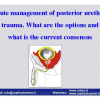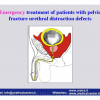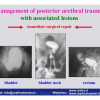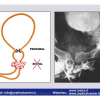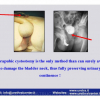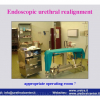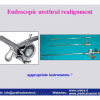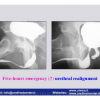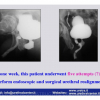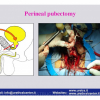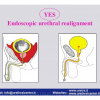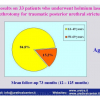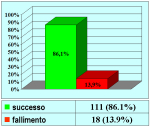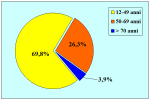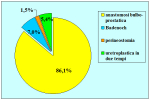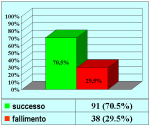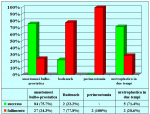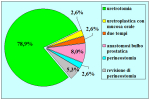| L’uretra maschile viene divisa in uretra posteriore ed uretra anteriore. L’uretra posteriore comprende il segmento che si estende dal collo vescicale allo sfintere uretrale distale e si divide in uretra prostatica ed uretra membranosa. L’uretra anteriore si estende dallo sfintere uretrale distale al meato urinario esterno e si divide in uretra bulbare, uretra peniena, uretra navicolare. L’uretra anteriore è circondata, per tutta la sua lunghezza, da un tessuto lacunare e ben vascolarizzato che viene chiamato corpo spongioso. L’uretra posteriore si divide in uretra membranosa ed uretra prostatica e comprende il segmento che si estende dal collo vescicale allo sfintere uretrale distale. L’uretra posteriore contiene i due sfinteri urinari, quello prossimale a livello del collo vescicale e quello distale a livello membranoso. |
Lettura n° 1:
| Initial evaluation and management of the patient with pelvic fracture urethral distraction defects (PFUDD) 1 December 2007 Rome – Italy |
 Scarica PDF |
|
|
|
||
| Lettura n° 2: | ||
| Incontinence following pelvic trauma 23rd Annual EAU Congress Sub-plenary Session on Male urinary incontinence March 26-29, 2008 Milan – Italy |
 Scarica PDF |
|
|
|
||
| Lettura n° 3: | ||
| Posterior Urethroplasty III Simposio Internacional de Cirurgia Urologica Reconstrutora April 11-12, 2008 Rio de Janeiro-Brazil |
 Scarica PDF |
|
|
|
||
| Lettura n° 4: | ||
| Chirurgia dell’uretra posteriore Mantova – Italy |
 Scarica PDF |
|
|
|
||
| Lettura n° 5: | ||
| Traumatic posterior urethral disruption. Pelvic fracture urethral distraction defects Congress of French Association of Urology ESU COURSE: Trauma in Urology November, 20 – 2008 Paris – France |
 Scarica PDF |
|
|
|
||
| Lettura n° 6: | ||
| Emergency and delayed treatment of patients with pelvic fracture urethral distraction defects 9th Conference of the Arab Association of Urology 7th International Conference of Jordanian Association of Urological Surgeons November 22 – 24, 2011 Amman – Jordan |
 Scarica PDF |
|
|
|
||
| Lettura n° 7: | ||
| Acute management of posterior urethral trauma. What are the options and what is the current consensus Muljibhai Patel Urological Hospital “URETHROPLASTY” July 19 – 20, 2012 Nadiad – Gujarat – India |
 Scarica PDF |
Articolo n° 1
Urethral trauma: radiological aspects and treatment options.
J Trauma. 1987 Mar; 27(3):256-61
Articolo n° 2
Posterior urethroplasty in children.
Eur Urol. 1987;13(1-2):110-5.
Articolo n° 3
Long-term results of anterior and posterior urethroplasty with actuarial evaluation of the success rates.
J Urol. 1997 Oct;158(4):1380-2.
Articolo n° 4
History and Evolution of Transpubic Urethroplasty:
A Lesson for Young Urologists in Training
Eur Urol 2007; 52:1290 – 1292
Urethral trauma: radiological aspects and treatment options.
J Trauma. 1987 Mar; 27(3):256-61
Articolo n° 2
Posterior urethroplasty in children.
Eur Urol. 1987;13(1-2):110-5.
Articolo n° 3
Long-term results of anterior and posterior urethroplasty with actuarial evaluation of the success rates.
J Urol. 1997 Oct;158(4):1380-2.
Articolo n° 4
History and Evolution of Transpubic Urethroplasty:
A Lesson for Young Urologists in Training
Eur Urol 2007; 52:1290 – 1292
1. Domanda: Per questo tipo di intervento quale tipo di anestesia è previsto?
Risposta: Anestesia generale con intubazione oro-tracheale.
2. Domanda: Quante ore dura l’intervento?
Risposta: Circa 3 ore.
3. Domanda: Ci sono rischi per l’erezione, la fertilità e la continenza urinaria, dopo l’intervento?
Risposta: Se il paziente non ha subito danni al collo vescicale durante il trauma del bacino o le manovre chirurgiche effettuate in emergenza, la continenza non è compromessa dall’intervento di uretroplastica posteriore. Comunque, lo studio radiologico preoperatorio è sempre in grado di stabilire se il collo vescicale è integro o se è stato danneggiato, quindi di stabilire se il paziente sarà incontinente dopo l’intervento. Nei pazienti con trauma del bacino è sempre presente una disfunzione erettile di vario grado dovuta alle lesioni traumatiche che si verificano durante la rottura dell’uretra. L’intervento di uretroplastica può, in alcuni casi, creare un ulteriore deficit erettile. Infine, l’intervento di uretroplastica posteriore non ha alcuna conseguenza sulla fertilità del paziente, sempre che il collo vescicale sia integro.
4. Domanda: Quanti sono i giorni di degenza in ospedale previsti per questo intervento?
Risposta: In genere il ricovero ospedaliero varia da 5 a 7 giorni.
5. Domanda: Per quanto tempo dovrò portare il catetere nell’uretra e la cistostomia sovrapubica dopo l’intervento?
Risposta: Il catetere deve rimanere in sede per quattro settimane dopo l’intervento, fino a quando verrà effettuata la prima radiografia di controllo postoperatoria. La cistostomia sovrapubica deve rimanere in sede per due mesi, fino a quando verrà effettuata la seconda radiografia di controllo postoperatoria.
6. Domanda: Quali particolari limitazioni sono suggerite durante la convalescenza?
Risposta: Durante la convalescenza è suggerito l’uso di un antibiotico per via orale fino a che non viene rimosso il catetere. È suggerito di non effettuare lungi viaggi in auto, lavori pesanti, attività sessuale e sportiva.
7. Domanda: Quanto tempo dopo l’intervento potrò riprendere la mia attività lavorativa, sportiva e sessuale?
Risposta: Le attività lavorativa, sportiva e sessuale possono essere riprese gradualmente dopo circa 30 giorni dalla rimozione del catetere.
8. Domanda: Dopo l’intervento posso usare la bicicletta od il motorino?
Risposta: L’uso di bicicletta, motorino, cavallo, mezzi a sella in palestra sono sconsigliati.
9. Domanda: Quali cibi e bevande devo evitare dopo l’intervento?
Risposta: L’uso di birra, vini spumanti e gassati sono controindicati. Un uso esagerato di cioccolata, cacao, frutta secca, crostacei non è consigliato.
Risposta: Anestesia generale con intubazione oro-tracheale.
2. Domanda: Quante ore dura l’intervento?
Risposta: Circa 3 ore.
3. Domanda: Ci sono rischi per l’erezione, la fertilità e la continenza urinaria, dopo l’intervento?
Risposta: Se il paziente non ha subito danni al collo vescicale durante il trauma del bacino o le manovre chirurgiche effettuate in emergenza, la continenza non è compromessa dall’intervento di uretroplastica posteriore. Comunque, lo studio radiologico preoperatorio è sempre in grado di stabilire se il collo vescicale è integro o se è stato danneggiato, quindi di stabilire se il paziente sarà incontinente dopo l’intervento. Nei pazienti con trauma del bacino è sempre presente una disfunzione erettile di vario grado dovuta alle lesioni traumatiche che si verificano durante la rottura dell’uretra. L’intervento di uretroplastica può, in alcuni casi, creare un ulteriore deficit erettile. Infine, l’intervento di uretroplastica posteriore non ha alcuna conseguenza sulla fertilità del paziente, sempre che il collo vescicale sia integro.
4. Domanda: Quanti sono i giorni di degenza in ospedale previsti per questo intervento?
Risposta: In genere il ricovero ospedaliero varia da 5 a 7 giorni.
5. Domanda: Per quanto tempo dovrò portare il catetere nell’uretra e la cistostomia sovrapubica dopo l’intervento?
Risposta: Il catetere deve rimanere in sede per quattro settimane dopo l’intervento, fino a quando verrà effettuata la prima radiografia di controllo postoperatoria. La cistostomia sovrapubica deve rimanere in sede per due mesi, fino a quando verrà effettuata la seconda radiografia di controllo postoperatoria.
6. Domanda: Quali particolari limitazioni sono suggerite durante la convalescenza?
Risposta: Durante la convalescenza è suggerito l’uso di un antibiotico per via orale fino a che non viene rimosso il catetere. È suggerito di non effettuare lungi viaggi in auto, lavori pesanti, attività sessuale e sportiva.
7. Domanda: Quanto tempo dopo l’intervento potrò riprendere la mia attività lavorativa, sportiva e sessuale?
Risposta: Le attività lavorativa, sportiva e sessuale possono essere riprese gradualmente dopo circa 30 giorni dalla rimozione del catetere.
8. Domanda: Dopo l’intervento posso usare la bicicletta od il motorino?
Risposta: L’uso di bicicletta, motorino, cavallo, mezzi a sella in palestra sono sconsigliati.
9. Domanda: Quali cibi e bevande devo evitare dopo l’intervento?
Risposta: L’uso di birra, vini spumanti e gassati sono controindicati. Un uso esagerato di cioccolata, cacao, frutta secca, crostacei non è consigliato.
| Risultati aggiornati al 31 dicembre 2021 | |||

Tabella pazienti |
|||




